#Megarhyssa
Text


@microecobus submitted: Hello onenicebug, i want to show you this majestic wasp which i found 2 years ago.
Still dont know what this species is. In my region, there is Megarhyssa perlata, but thorax markings coloration are off, so it must be another species
I'd need to know the location to be sure but it looks like a male Megarhyssa perlata. Females have different markings and of course the long ovipositor.
138 notes
·
View notes
Text

i drew a wauce
#megarhyssa#giant icheneumon wasp#pipi#bugs#mi sitelen#idgaf rent lowering bug post everyone go home#a little undetailed and innacurrate but you must be nice to me about it
6 notes
·
View notes
Text

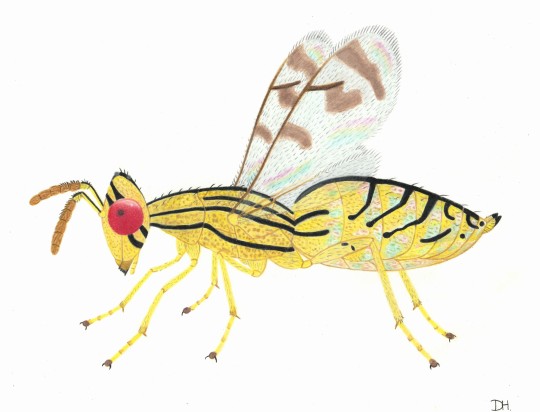
This is not a completed piece of art. I plan on drawing more cool wasps and eventually making a poster. I've just been going through a hard time recently, and I haven't had as much inspiration. Depression is hitting me a bit. Here are all the ones I've done so far. If anyone has a suggestion for a very obscure, specific, and weird wasp, let me know! You might spark my inspiration and motivation!
#hymenoptera#insect#entomology#wasp#wasps#apocrita#aculeata#Marietta#Galearia#Leucospis#Eutrichosoma#Dasymutilla#Pelecinus#Cameronella#Vespula#Megarhyssa#Agamerion#Sphex#Chrysis#art#traditionalart#illustration#workinprogress#Zagrammosoma#parasitica#colouredpencils
136 notes
·
View notes
Text

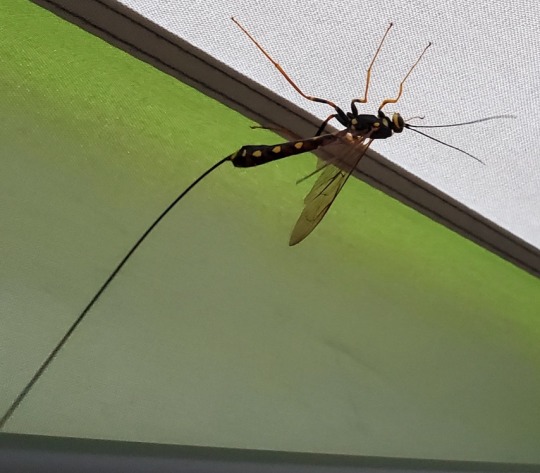
Look at the crazy ovipositor on this Western giant ichneumon wasp (Megarhyssa nortoni nortoni). Females of this species have ovipositors 2-3 inches (51-76 mm) long! Even though it looks intimidating, they can't sting. The long ovipositor is used to pierce tree bark and lay eggs on horntail (wood wasp) larvae. When the egg hatches, the ichneumon wasp larva eats the wood wasp larva from the inside (ie it's a parasitoid).
Sierra Mountains, California, US
#giant ichneumon wasp#megarhyssa nortoni#that ovipositor#wasp#cool animals#creature#ovipositor#bugs#nature#nature photography#biodiversity#animals#arthropods#inaturalist#bugblr#entomology#insect appreciation#invertebrates#inverts#hymenoptera#wasps are cool#biology
67 notes
·
View notes
Text
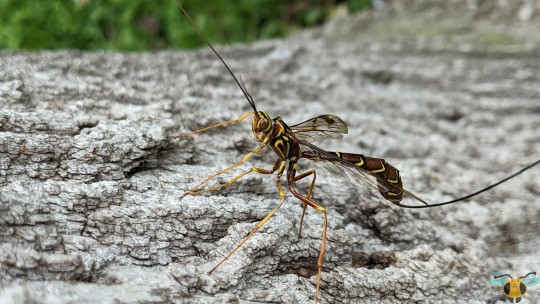


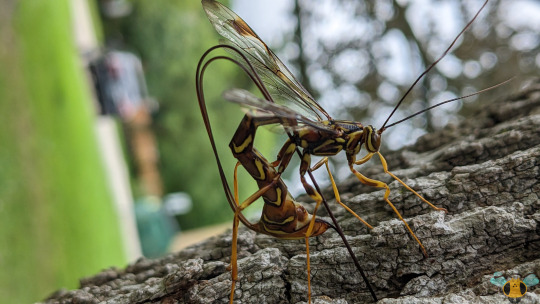
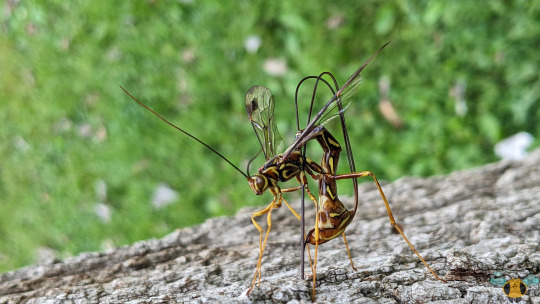




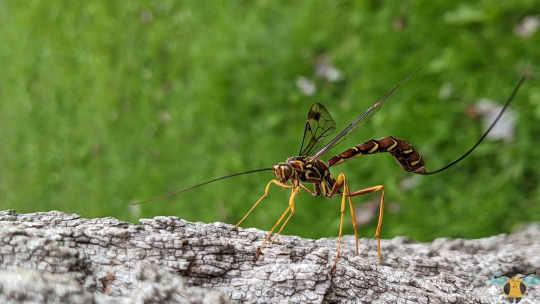
Long-Tailed Giant Ichneumonid Wasp - Megarhyssa macrurus
To anyone wondering why this giant wasn't included in the "Insect Highlights of 2023", it's simply because there were enough pictures taken to allow a second showcase! She's a very impressive creature, and I'm fortunate to have found her last year. I hope to find a few more specimens in the future, especially if they revisit the tree this one was exploring or similar trees in the surrounding area. As a reminder, Giant Ichneumonids like this specimen are drawn to old, decaying trees in search of Pigeon Horntail larvae for their own eggs. Using their elongated ovipositor they pierce through the wood like a syringe, paralyze a developing larva and place an egg on it. This whole process is done without even so much as seeing the larvae hidden in the tree trunk, but they are searched for via scent cues on the bark, listening for sounds via her legs and feeling for them with her sting as it is pressed downward! Though it looks unwieldy, it is surprisingly easy for an Ichneumon Wasp of this size to orient itself to "drill for larvae". When she's decided on a suitable location, she extends her abdomen and legs as far as they will go, orienting her ovipositor to be as vertical as possible! Since the ovipositor is long, it will take a series a fine adjustments to pull it in so that it lines up parallel to the abdomen.
After it is pressed into the tree trunk the ovipositor is fully unsheathed and the Long-Tailed Giant's search proceeds. The individual in these pictures had just begun to drill for larvae (and had re-sheathed upon my return 1 hour later) Although it may seem precarious, it's important to keep in mind that the ovipositor (which can be more than twice the length of the insect’s body) is not a stiff filament. It appears stiff while inside its sheath and carried behind the insect under normal circumstances. In fact, it is somewhat flexible and can be maneuvered around tree-bound obstacles while searching for larvae. The flexibility also offers an easier exit when withdrawing from the hole in the tree, but not a hasty one: should the ovipositor became damaged, the Wasp will not be able to lay eggs, so withdrawal is monitored carefully. If you'd really like to see an unwieldly "stinger", try and observe an Ichneumon flailing the ovipositor around and place it smoothly back inside her sheath! Do not fear when observing this imposing beauty; though the ovipositor is long and prominent, her "stinger" cannot harm a human. As you've read above, her stinging process requires a lot of telegraphing to be effective, and Ichneumonid adults are not predators nor are they interested in humans. Though Wasps, there is a world of difference between Ichneumonids and some of the more common social Wasps of Ontario.
Pictures were taken on August 24, 2023 with a Google Pixel 4.
#jonny’s insect catalogue#ontario insect#wasp#ichneumon wasp#long tailed giant ichneumonid wasp#megarhyssa macrurus#giant ichneumon#hymenoptera#insect#toronto#august2023#2023#nature#entomology#invertebrates
15 notes
·
View notes
Text
Wasp (and bee and sawfly) holding year in review


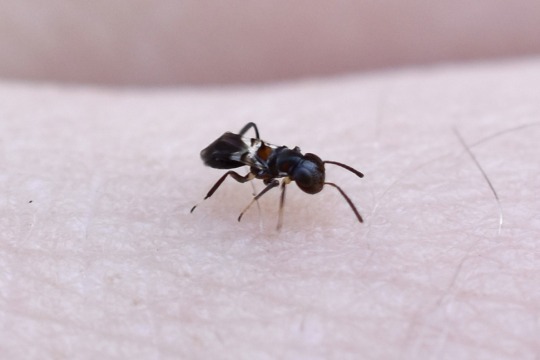
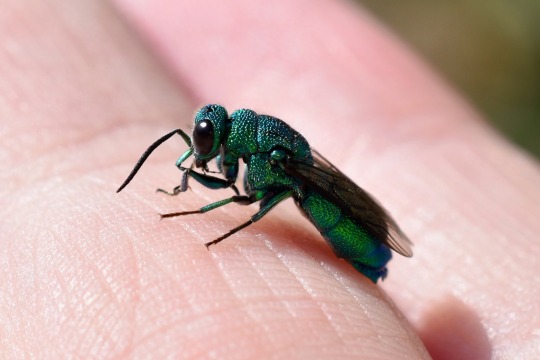


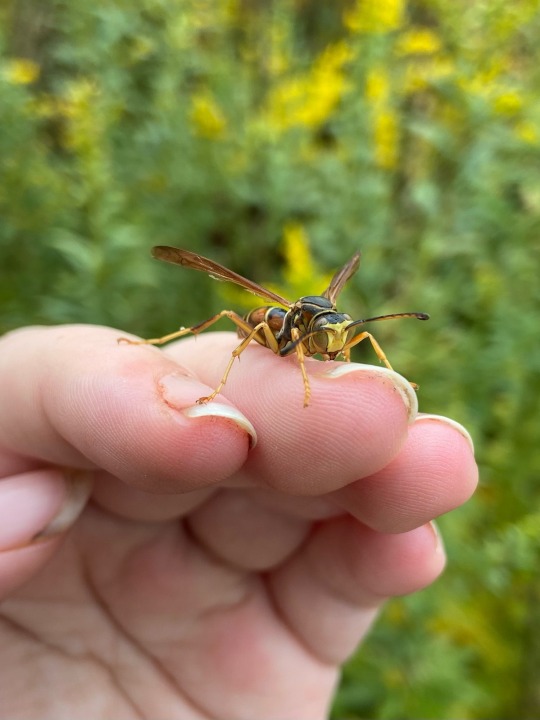
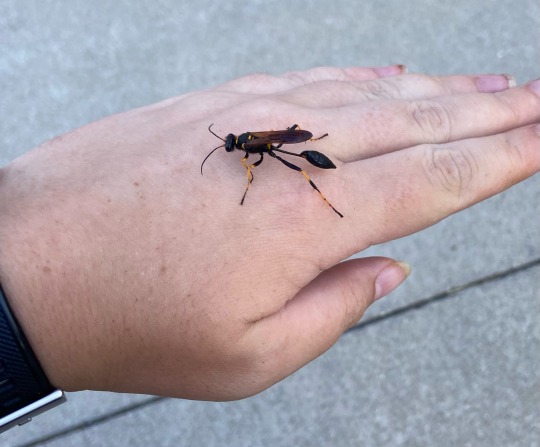
From left to right and top to bottom, these are: gall wasp (maybe genus Zopheroteras), sawfly (Dolerus sp.), parasitoid wasp (Encyrtus sp.), cuckoo wasp (Chrysis sp.), unidentified parasitoid wasp, calliopsis cuckoo nomad bee (Holcopasites calliopsidis), male northern paper wasp (Polistes fuscatus), yellow-legged mud-dauber (Sceliphron caementarium)

And my favorite find of the year: a Greene’s giant ichneumonid (Megarhyssa greenei)
All individuals shown here either cannot sting or have very mild stings
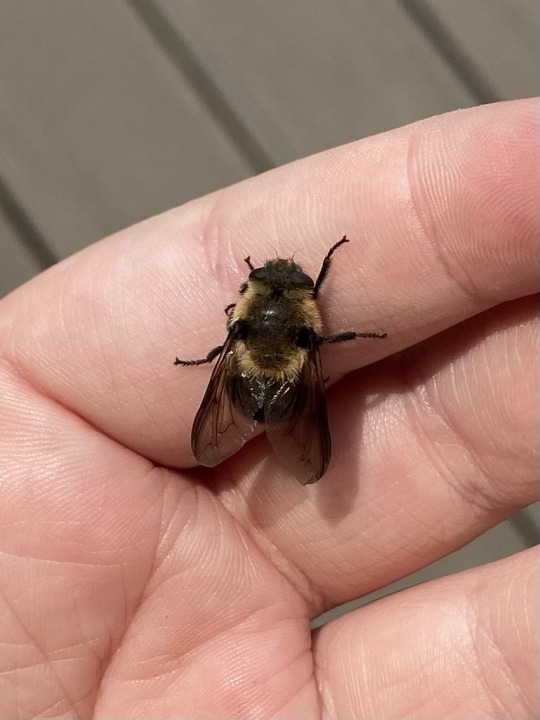
Bonus: a convincing bumblebee mimic, the deer bot fly (Cephenemyia sp.)
123 notes
·
View notes
Text
Uncharismatic Fact of the Day
As every expecting mother knows, finding the perfect place to lay your eggs is of the utmost importance. That's why the long-tailed giant ichneumonid wasp has such a long ovipositor! This special organ is more than twice the wasp's body length, and is used to tunnel deep into decaying wood in order to deposit their egg on the body of their host species the pigeon horntail (Tremex columba).

(Image: A female long-tailed giant ichneumonid wasp (Megarhyssa macrurus) depositing her egg by Richard Orr)
If you like what I do, consider leaving a tip or buying me a ko-fi!
#long-tailed giant ichneumonid wasp#hymenoptera#Ichneumonidae#giant ichneumonid wasps#ichneumonid wasps#wasps#hymenoptrids#insects#arthropods#uncharismatic facts
166 notes
·
View notes
Note


I found a Megarhyssa wasp. Not sure which species. Found in the midwest, America. Do you have any idea what species this could be? Sorry, was unable to get an upper shot on time.
don’t have the expertise to say from those photos
65 notes
·
View notes
Photo


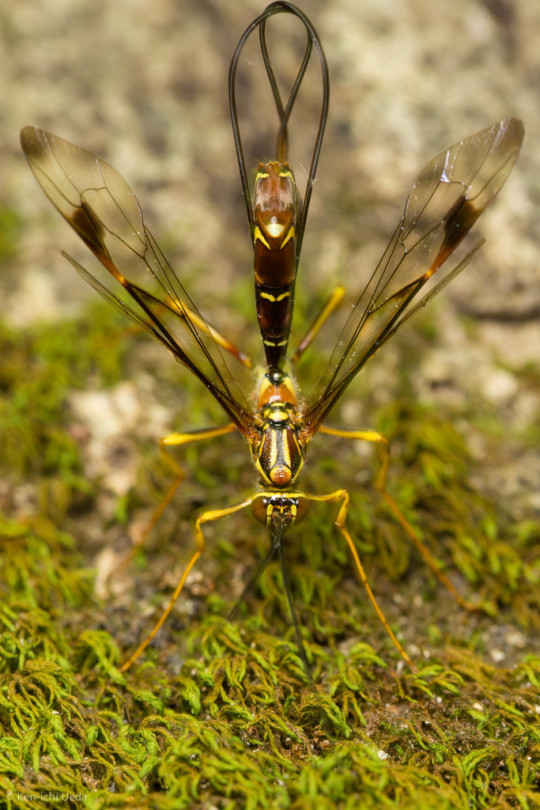
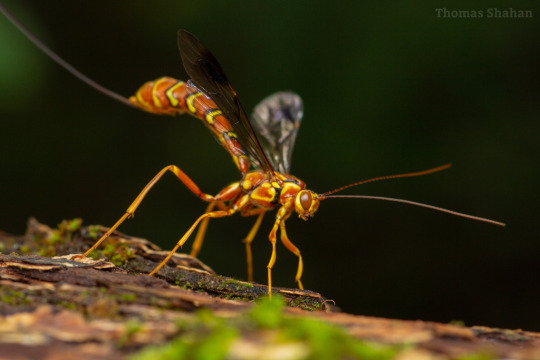
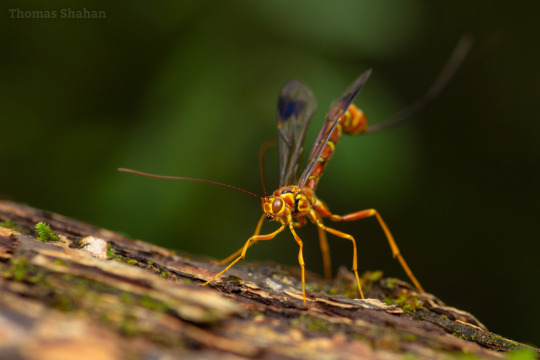
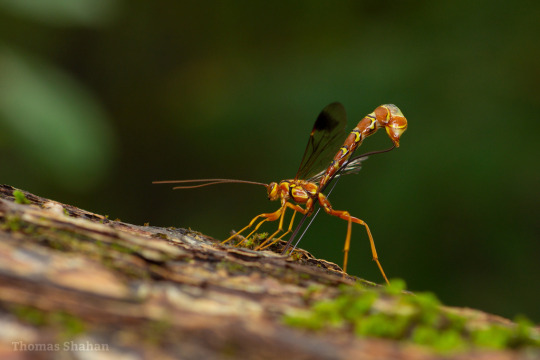
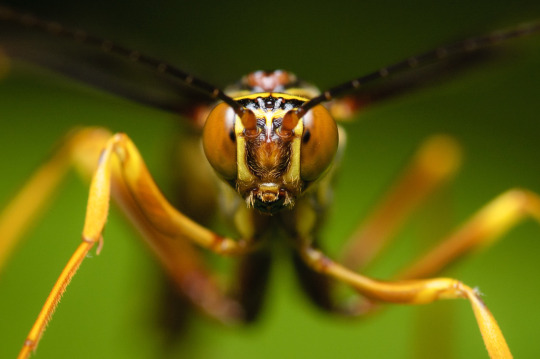
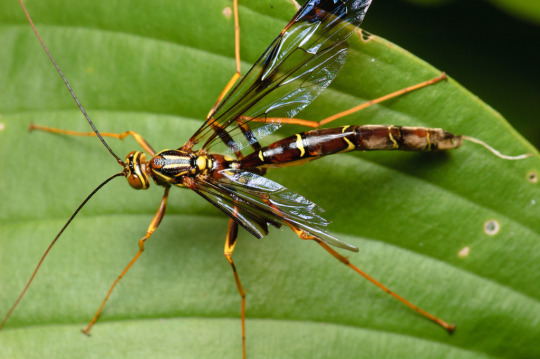


Long-tailed giant ichneumonid wasp, Megarhyssa macrurus, Ichneumonidae
Found in the eastern United States and up into southern Canada.
This species is a parasitoid of the larvae of the pigeon horntail, which bore tunnels in decaying wood. Female wasps detect larvae in the wood and use their long ovipositor to drill to them, paralyzing and laying an egg on the horntail larva. The wasp larva will then consume the body of the horntail larva before pupating and emerging as an adult wasp.
Photos 1-3 by kueda, 4-6 by tshahan, 7-8 by claggy, 9 by nashuagoats, and 10 (for scale) by shloftus
#animals#curators on tumblr#insects#bugs#wasp#ichneumonid wasp#Megarhyssa#giant ichneumonid wasp#long tailed giant ichneumonid wasp#one nice bug#parasitoid#bug death#mentioned
635 notes
·
View notes
Text


Drawing of the day: Megarhyssa greenei. Bonus mini collage of my favourite non-cartoon wasp drawings. I plan on adding more as I go along. For now, this is only a sample. Drawing wasps is keeping me sane during these dark times. Which one is your favourite?
#hymenoptera#insect#entomology#wasp#wasps#apocrita#aculeata#vespoidea#vespidae#vespinae#Vespulaintermedia#Ichneumonoidea#Ichneumonidae#Rhyssinae#Megarhyssagreenei#Apoidea#Sphecidae#Sphexlatreillei#Chrysidoidea#Chrysididae#Chrysidinae#Chrysisequestris#illustration#traditionalart
1K notes
·
View notes
Note
Trick or Treat!
You get one (1) Megarhyssa macrurus

31 notes
·
View notes
Text
thoughts after doing my updated pinned post: while I would like to get out of my comfort zone a bit more w my fanfic/smut this year (it's fun and builds writing skill!), it also doesn't really bother me to be, for the most part, The Guy Who Writes Power Imbalance/Manipulation/Sex That's About Conquest, in the sense that a thriving ecosystem of excellent fanficcers can contain all sorts of creatures suited to very particular niches in addition to its generalists.
if you are the sort to binge watch a playlist of "predatory flatworm hunts and eats [other invertebrate]" YouTube videos you will enjoy seeing some pretty boy or naïve activist taken apart in a dozen different ways in a dozen different places in my little oneshots; how fascinating that it's such an incredibly simple animal compared to most predators, but the way it injects digestive enzymes into its prey and eats them half-dissolved...! for some, pondering it once is enough; for others they will develop a fascination with these other tiny invertebrate monsters, the slave-making ants, the parasitoid wasps too, quoting Darwin's "I cannot persuade myself that a beneficent and omnipotent God would have designedly created the Ichneumonidae with the express intention of their feeding within the living bodies of Caterpillars..."
and yet this is such a tiny fraction of the incredible richness of the biological world; there are uncountable species and behaviors and relationships people might find interesting. I am just one writer, or just Megarhyssa atrata drilling for the larvae of the wood wasp, or the deceitful Polyergus lucidus queen; may you witness and enjoy my ambitious American appetites as another tiny piece of the great and terrible tapestry of human sexuality, whether or not my works are the sort you care to linger on.
13 notes
·
View notes
Text
Hmm, what are some bugs that run fast and/or give track runner vibes? I want to draw my megarhyssa macrurus character in a race, and I'm stumped on other species to add.
(and heading off the most obvious answer, i already have tiger beetle on the list)
#rambling#ive been wanting to draw viridian for a while and apparently it's a go big or go home type deal#we'll see if i can follow through but i can at least do a sketch!
15 notes
·
View notes
Text


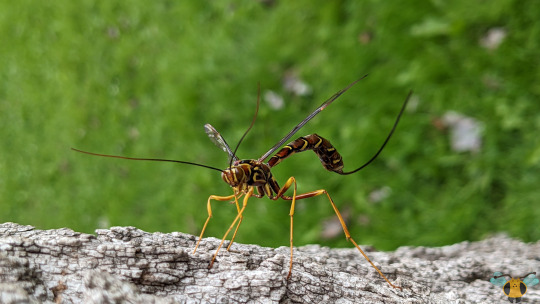







Long-Tailed Giant Ichneumonid Wasp - Megarhyssa macrurus
After finding this specie just yesterday, uploading Tuesday's post now feels like the appetizer before today's main course: one of the largest Ichneumon Wasps you'll find in North America! This insect is so iconic and recognizable that it actually has a common name! That name perfectly encapsulates this insect's features: its giant size (easily dwarfing that of other Ichneumonids) and its long tail, represented by a long, flexible abdomen tipped with an elongated ovipositor. Have a glance at Picture 5 and behold the length; the ovipositor is easily twice the length of the insect's body. Despite the formidable appearance of a potential angry Wasp wielding what appears to be sword for a stinger, she is 100% harmless to humans. She has no bite and her ovipositor is not designed for defense. Even if the latter was, it's fair too unwieldly to use in an instant. She would have to telegraph her sting by contorting into the posture in Pictures 1, 2, 4 and 7. The worst she can do is charge at you in an attempt to frighten you away should you step too close to her tree (as I found out during my observation).
When observing Giant Ichneumonids such as this one, pay close attention to their wings, abdomens and their faces. All those features are necessary for an accurate identification. For one example, male Wasps within Megarhyssa tend to be smaller, have less complex abdomens and lack an ovipositor, but are relatively large compared to other Ichneumonids. Secondly, of the 4 Giant Ichneumon species that call North America home, the female of this specie - M. macrurus - has the potential to be mistaken for Greene's Giant Ichneumonid Wasp (M. greenei), especially since the latter's subspecies have tremendous variability depending on their latitude. To distinguish between the two, the Long-Tailed Giant has more regions in its wings with pigmentation (as opposed to simply one large area), its head has distinct vertical stripes (Picture 9 provides a good look at what to expect), and the ovipositor is a very long one (M. greenei's ovipositor is supposedly 1.5 times the body length). For the latter, you'll need to eyeball it unless you intend to capture and measure the specimen yourself. Of course, I prefer to observe and photograph. Speaking of which, what is today's specimen doing on this tree? What is she looking for?
As I documented her, this Wasp monitored this tree for nearly 2 hours in search of the perfect spots to drill into the tree's trunk. Her searching activity on this tree implies that portions of the wood are afflicted with disease or have begun to decay. Those holes in the bark may indicate some trouble, but those holes were not made by her actions, nor the insects she's looking for. She's searching for the developing larvae of the Pigeon Horntail, (ironically) another harmless giant Hymenopteran that drills into old, decaying wood with its own ovipositor. Just like other Ichneumon Wasps, the giant's offspring are parasitic, feeding off of creatures that have been paralyzed by the mother's sting. When coiled up in the upright position, the Wasp unsheathes her great ovipositor and positions it and herself to drill downward through the wood to find larvae that she can place her eggs on. I believe her to be successful a few times here as I noticed the underside of her abdominal tip was pulsing rhythmically while the ovipositor remained steady. What's astounding is the process by which larvae are located. You see, the Pigeon Horntail merely needs to place eggs inside the tree and then go to the next tree. The Giant Ichneumon needs to seek out a Horntail larvae and place its eggs on it without even seeing it! The mother Wasp goes purely based on scent cues from her antennae and then feeling her way through the wood using her ovipositor.
Pictures were taken on August 24, 2023 with a Google Pixel 4.
#jonny’s insect catalogue#ontario insect#wasp#ichneumon wasp#long tailed giant ichneumonid wasp#megarhyssa macrurus#giant ichneumon#hymenoptera#insect#toronto#august2023#2023#nature#entomology#invertebrates
6 notes
·
View notes
Photo
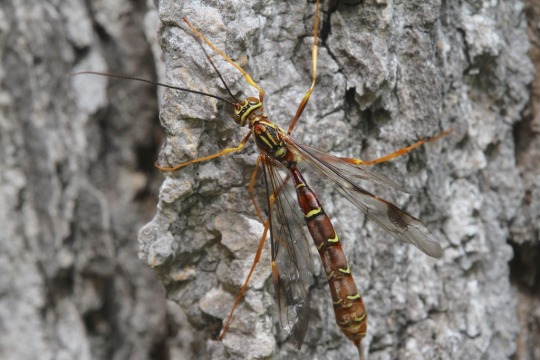



Megarhyssa macrurus, also known as the long-tailed giant ichneumon wasp
“I pollinate, I build nests fit for a queen, I consume swarms of parasitic pests.
Call me hornet, wasp, yellow jacket, vespa, we coexist.
When one tugs at a single thing in nature,
one finds it attached to the rest of the universe.”
-Janet Austin
50 notes
·
View notes
Text
I looked up what bug this is, she is named Megarhyssa macrurus. she uses her tail to lay her eggs in the nests of other insects, who are burrowed in wood. when her eggs hatch they kill and eat the young of the other insect lol. what an odd bug!
5 notes
·
View notes